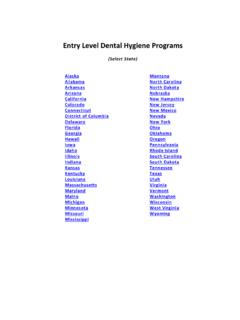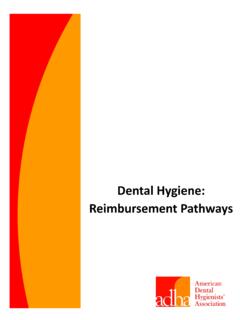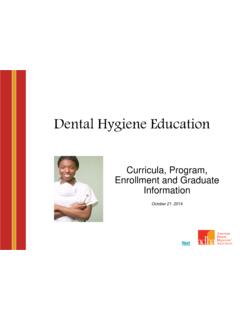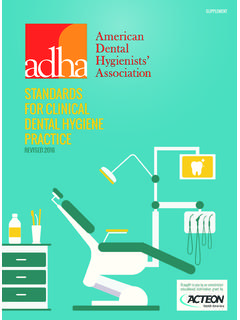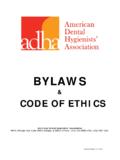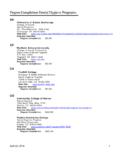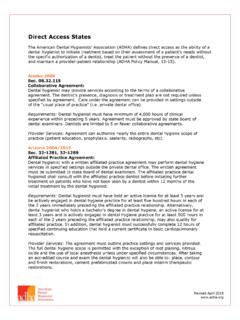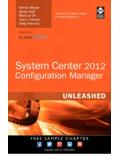Transcription of About Accreditation - ADHA
1 Page | 1 August 2016 FAQs About Dental Hygiene Education Programs and Accreditation About Accreditation Q: Does ADHA accredit dental hygiene programs? A: No. While ADHA continues toward the goal of professional autonomy, which includes educational autonomy, the profession does not currently control all aspects of dental hygiene education. Entry level educational programs are accredited by the Commission on Dental Accreditation (CODA). Q: What does Accreditation mean? A: Accreditation is a peer review process of educational institutions or programs by an independent body that assesses and evaluates the quality of the institution and/or programs that it offers. There are two types of Accreditation in the : (1) institutional (typically provided by a regional accrediting agency) and (2) specialized programmatic (provides Accreditation for a specific program of study). The Commission on Dental Accreditation was established in 1975 and is nationally recognized by the United States Department of Education (USDE) as the sole agency to accredit dental and dental-related education programs conducted at the post-secondary level.
2 CODA's mission is to serve the oral health care needs of the public through the development and administration of standards that foster continuous quality improvement of dental and dental related educational programs. CODA defines Accreditation as an evaluation process where an organization or agency ( , the Commission) uses experts in a particular field of interest or discipline ( , dental education) to define standards of acceptable operation/performance for universities/programs/organizations and measures compliance with them. The mission of the Commission on Dental Accreditation (CODA) is to serve the public by establishing, maintaining and applying standards that ensure the quality and continuous improvement of dental and dental-related education and reflect the evolving practice of dentistry. The scope of the Commission on Dental Accreditation encompasses dental, advanced dental and allied dental education programs. Page | 2 August 2016 Q: Can a dental hygiene program open without CODA Accreditation ?
3 A: While graduation from an accredited program is a requirement for dental hygiene licensure, CODA Accreditation is voluntary. A program may open without CODA Accreditation ; however its graduates would not be eligible for licensure in most states. Q: Do students who graduate from a for-profit program receive the same level of education as a non-profit program? A: During its review process, the Commission evaluates programs in relation to predetermined standards which afford educational institutions latitude and flexibility in program development and implementation. In evaluating the educational process, the Commission applies the established Accreditation standards for each discipline uniformly to all programs. CODA Accreditation Standards. All students who graduate from a CODA accredited program are eligible to sit for national and regional board exams in order to become a licensed dental hygienist. Proliferation of Programs Q: Does CODA take into account the number of existing dental hygiene programs in a specific area when a new program is seeking Accreditation ?
4 A: Recently revised language in the Initial Application for CODA program Accreditation reads: 1. Describe the results of the institutional needs assessment that provided the basis for initiating a new program. 2. Provide evidenced-based documentation of current and local/regional data which verifies an adequate patient population, qualified faculty and administration, and present employment opportunities for graduates. Q: Does CODA take into account the saturation level of dental hygienists in a specific area when a new program is seeking Accreditation ? A: When a new program applies for initial Accreditation through CODA, the following is now included as part of the Initial Application: 1. Describe the results of the institutional needs assessment that provided the basis for initiating a new program. 2. Provide evidence based documentation of current and local/regional data which verifies an adequate patient population, qualified faculty and administration, and present employment opportunities for graduates.
5 Q: Does CODA regulate the number of graduates allowed at a specific program? A: The mission of CODA is to serve the public by establishing, maintaining and applying standards that ensure the quality and continuous improvement of dental and dental-related education and reflect the evolving practice of dentistry. The Commission s purview is the quality of educational programs, as opposed to the effect of graduates on the job market; therefore the Commission considers the number of program graduates only in terms of program resources. Page | 3 August 2016 Q: Is ADHA aware of the current unemployment climate for dental hygienists? A: Yes, and ADHA has developed a number of employment resources for members including: The Career Center An employment reference guide A Path to a New Career FAQ Career Opportunities in Public Health Presentation Leadership workshops An environmental scan detailing the future outlook of the profession CE courses at annual conference Valuable networking and volunteer opportunities Transforming Dental Hygiene Education and the Profession for the 21st Century For a list of all member benefits please visit Q: What is ADHA doing to advocate on behalf of dental hygienists in regard to the proliferation of schools?
6 A: The approach is two fold; at the national and local level. The ADHA Division of Education maintains a current data base of all accredited dental hygiene education programs by state. This is a listing of educational programs which offer degrees or certificates that provide entry to the professional practice of dental hygiene. ADHA s Division of Education along with the Education Advisory Group regularly review the Accreditation Standards for Dental Hygiene Education Programs developed by CODA, and has provided ongoing comments to CODA regarding recommended changes. While some of the recommendations made by ADHA have been adopted, those that have not continue to be revisited by the Education Advisory Group who continue to pursue these recommendations through CODA. ADHA staff regularly attends CODA meeting open sessions, including those of the full Commission as well as the Dental Hygiene Review Committee. In 2010 - 2011, ADHA coordinated a letter writing campaign that resulted in CODA receiving nearly 700 letters from ADHA members expressing concern About the proliferation of programs and urging CODA to REQUIRE that new dental hygiene programs conduct a comprehensive needs assessment prior to applying for Accreditation .
7 CODA adopted this change on February 3, 2012, with an implementation date of January 1, 2013. The most significant advocacy role to address the opening of new dental hygiene education programs is through the state and local dental hygiene association: State higher education authorities seek state based or regional based workforce information that assists them in making decisions regarding program need in their specific geographical area. When potential programs contact our office for information or guidance, ADHA recommends they complete an analysis of the local, state, and regional employment market and review existing programs in the area. ADHA provides them with ADHA state contacts so they can obtain employment information firsthand. ADHA assists state and local associations in determining a strategy in approaching developing programs. Page | 4 August 2016 Q: I ve heard rumors that a program is developing in my area. Who can I contact to express my concern?
8 A: There are several steps involved in establishing a new program. First, institutions of higher education that wish to sponsor a dental hygiene education program seek approval through the state. Secondly, programs seek voluntary Accreditation from the Commission on Dental Accreditation . FOR DEVELOPING PROGRAMS IN THE PROCESS OF SEEKING STATE APPROVAL: Individuals or state dental hygiene associations who wish to contact one or more state education organizations/agencies may consult the ADHA Education Database available under Members Resources. The ADHA Higher Education Database contains information such as Higher Education Agencies, Organizations of Independent (Not-for-Profit) Colleges and Universities, Proprietary (For-Profit) Private Higher Education, State Board of Regents, Accreditation , and Regional Boards of Higher Education. Included in this database are specific questions you may wish to ask (as appropriate to your region, your state, your community), as well as resources and data that the state association could offer.
9 FOR DEVELOPING PROGRAMS IN THE PROCESS OF SEEKING CODA INITIAL Accreditation : Individuals or state dental hygiene associations may wish to contact the director or dean at the developing institution. A list of specific questions you may wish to ask (as appropriate to your region, your state, your community), as well as resources and data that the state association could offer are available on the ADHA website in Member Resources. You might also offer to sit on the program s advisory committee, so you have the opportunity to offer suggestions as the program develops. While specific CODA program application information is confidential and will not be discussed, you may also contact CODA to share data and express concerns. The initial CODA contact is: Patrice Renfrow, Manager, Allied Dental Education, Commission on Dental Accreditation (CODA) at: or by phone at: 312 440 2695. Q: How can I stay up-to-date on ADHA s initiatives regarding the proliferation of dental hygiene programs?
10 A: Regularly monitor all of the ADHA communication channels, Spotlight, listservs and ADHA Update for the latest educational advocacy updates. The ADHA website is also updated regularly with information. Please visit to find more information. ADHA s Role in For-Profit Programs Q: What is ADHA s position on For-profit programs? A: Existing ADHA policies regarding the opening of new programs most notably support that there must be a demonstrated need for a new program. ADHA s advocacy role with the Commission on Dental Accreditation is to continue to express the importance of a comprehensive needs assessment prior to the granting of initial Accreditation status of any proposed dental hygiene education program. ADHA has provided specific Page | 5 August 2016 recommendations to the Commission to require developing programs that seek Accreditation demonstrate evidence supporting the need for the program. CODA adopted this change on February 3, 2012, with an implementation date of January 1, 2013.
